
Love or hate the Silverstone TJ07 (personally, I'm not really a fan), it certainly has its merits in the internal design. For example the layout is compartmentalised allowing for a massive 3x120mm radiator and pump, in addition to the PSU along the bottom. Integrated fan grills sit on either side allowing air to flow across. It's just like the Lian Li we saw with the last Vadim, although the TJ07 feels just half the size.
Then in the top there is the perfect space for a 2x120mm radiator and fans that neatly slot in above the motherboard. They are the same blue LED fans used here that were in the Cepheus Q80, but there's only eight this time round.
Despite this stack of potential airflow, the whole thing is incredibly quiet. This is all thanks to the fan (and pump) controller from mCubed Tech - the T-Balancer bigNG.
The acrylic top has been removed so it'll fit neatly behind the rear side, and the four channel unit works extremely well in monitoring the temperature of the ambient temp, graphics card and CPU and adjusting the air and water flow accordingly. However, it did have a tendency to go a little haywire occasionally - because the LEDs in the fans are directly linked to the input voltage, the controller seems to momentarily flick between high and low voltages as you load the system and the temperature fluctuates, causing the fans to "flash". It didn't happen often, but it was strange and rather obvious to see it "sneeze".
When we reported the issue to Vadim, he told us that it was an easy problem to fix and he offered to send one of his team on the four-hour round trip to fix it. With an insight into how Vadim's company works, we'd expect his customers to get the same treatment - it's just a shame that it wasn't picked up before the machine arrived at the bit-tech offices.
The cable routing rightly deserves to be labelled "supreme" - the differentiation between water tubing and power cables is difficult at best, and everything else seems to be hidden in nooks and crannies. Only the cables behind the side you'll never remove look less aesthetically pleasing, but because you'll never remove the other side panel, you'll never see them anyway.
The insides would do well with a black powder-coating to really finish the look. Somehow metallic silver still retains the look of a PC case, however I feel obliged to point out I'm struggling for criticism at this point and am being pedantic at best.
The BlastFlow Siberian 8800 GTX waterblock is used and has now gone into full production with slight modifications than the preview block we've again got here, however we've been informed that the performance is entirely unaffected. Despite the fact we never had instability in our initial testing and some excellent overclocking results, some are concerned that the memory and PWM heatsink is effectively passively cooled.
Inside there's a heavily overclocked Q6600 G0 stepping at 388x9 for 3.492GHz (a 46 percent overclock) with a whopping 1.5875V core voltage and 1.5V front side bus termination voltage. The memory is running at an almost native 1164MHz (versus 1150MHz) at its rated values of 5-5-5-18-2T at 2.4V. There would be arguably better performance from running at a lower speed at ultra low latency, but the effect is negligible at best.
Upgrading will be a real pain in the backside though, as the watercooling gets in the way for the large part. The hard drives are right behind the reservoir and getting an IDE or more SATA cables in is difficult at best. So the systems appeal is in a bit of a conflict - it's a PC that should last for a long while, yet, the case with its paintjob should outlast that even so upgrading literally means a whole new set of internals. As long as the PC is within warranty it can be upgraded for you though.
Then in the top there is the perfect space for a 2x120mm radiator and fans that neatly slot in above the motherboard. They are the same blue LED fans used here that were in the Cepheus Q80, but there's only eight this time round.
Despite this stack of potential airflow, the whole thing is incredibly quiet. This is all thanks to the fan (and pump) controller from mCubed Tech - the T-Balancer bigNG.
The acrylic top has been removed so it'll fit neatly behind the rear side, and the four channel unit works extremely well in monitoring the temperature of the ambient temp, graphics card and CPU and adjusting the air and water flow accordingly. However, it did have a tendency to go a little haywire occasionally - because the LEDs in the fans are directly linked to the input voltage, the controller seems to momentarily flick between high and low voltages as you load the system and the temperature fluctuates, causing the fans to "flash". It didn't happen often, but it was strange and rather obvious to see it "sneeze".
When we reported the issue to Vadim, he told us that it was an easy problem to fix and he offered to send one of his team on the four-hour round trip to fix it. With an insight into how Vadim's company works, we'd expect his customers to get the same treatment - it's just a shame that it wasn't picked up before the machine arrived at the bit-tech offices.
The cable routing rightly deserves to be labelled "supreme" - the differentiation between water tubing and power cables is difficult at best, and everything else seems to be hidden in nooks and crannies. Only the cables behind the side you'll never remove look less aesthetically pleasing, but because you'll never remove the other side panel, you'll never see them anyway.
The insides would do well with a black powder-coating to really finish the look. Somehow metallic silver still retains the look of a PC case, however I feel obliged to point out I'm struggling for criticism at this point and am being pedantic at best.
The BlastFlow Siberian 8800 GTX waterblock is used and has now gone into full production with slight modifications than the preview block we've again got here, however we've been informed that the performance is entirely unaffected. Despite the fact we never had instability in our initial testing and some excellent overclocking results, some are concerned that the memory and PWM heatsink is effectively passively cooled.
Inside there's a heavily overclocked Q6600 G0 stepping at 388x9 for 3.492GHz (a 46 percent overclock) with a whopping 1.5875V core voltage and 1.5V front side bus termination voltage. The memory is running at an almost native 1164MHz (versus 1150MHz) at its rated values of 5-5-5-18-2T at 2.4V. There would be arguably better performance from running at a lower speed at ultra low latency, but the effect is negligible at best.
Upgrading will be a real pain in the backside though, as the watercooling gets in the way for the large part. The hard drives are right behind the reservoir and getting an IDE or more SATA cables in is difficult at best. So the systems appeal is in a bit of a conflict - it's a PC that should last for a long while, yet, the case with its paintjob should outlast that even so upgrading literally means a whole new set of internals. As long as the PC is within warranty it can be upgraded for you though.

MSI MPG Velox 100R Chassis Review
October 14 2021 | 15:04

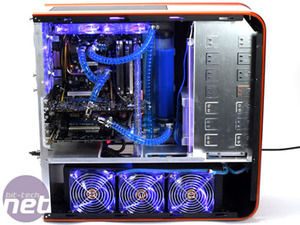
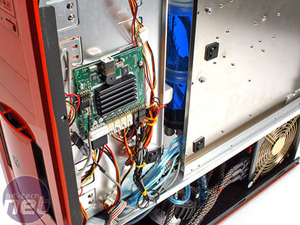
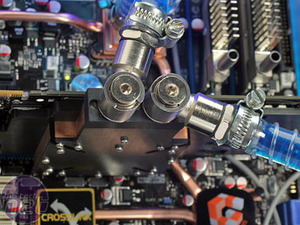
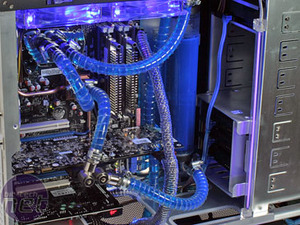
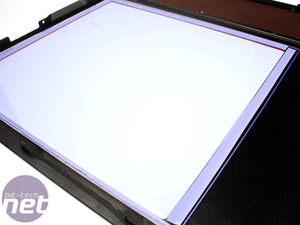








Want to comment? Please log in.